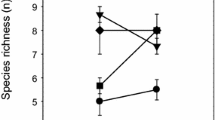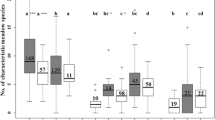Abstract
Topographic heterogeneity as a determinant of insect diversity pattern has been little studied. Responses of grasshopper assemblages to three hill sizes were assessed in the arid Succulent Karoo, South Africa. This area is one of the world’s 25 hotspots for conservation priorities. Small hills overall were more speciose than medium or large hills. There were also significantly higher densities of small-sized grasshoppers on small hills than on medium or large ones. The slopes of the three hill sizes did not differ significantly either in their species richness or abundance, and there was no significant difference in species richness between summits only of the three hill sizes. Patterns of grasshopper species dominance were markedly variable among sites, but with clear differences between small and larger hills, associated with vegetation characteristics. Vegetation cover and grass cover was less on the small hills. Grasshopper taxonomic groups varied among the three hill sizes, with small hills being taxonomically more diverse, supporting species from four families and nine subfamilies, while medium and large hills only supported Acrididae. It is concluded that topography has a remarkably strong effect on various aspects of grasshopper spatial heterogeneity and that small hills in particular are a major factor to consider in spatial conservation planning.
Similar content being viewed by others
References
G.E. Belovsky J.B. Slade (1995) ArticleTitleDynamics of two Montana grasshopper populations: relationships among weather, food abundance and interspecific competition Oecologia 101 383–396 Occurrence Handle10.1007/BF00328826
H.C. Bennett-Clark (1990) Jumping in Orthoptera R.F. Chapman A. Joern (Eds) Biology of Grasshoppers Wiley New York 389–406
H.E. Braker (1989) ArticleTitleEvolution and ecology of oviposition on host plants by acridid grasshoppers Biol. J. Linn. Soc. 38 389–406
J.H. Brown (1984) ArticleTitleOn the relationship between abundance and distribution of species Am. Nat. 124 253–279 Occurrence Handle10.1086/284267
M.F. Claridge J.S. Singhrao (1978) ArticleTitleDiversity and altitudinal distribution of grasshoppers (Acridoidea) on a Mediterranean mountain J. Biogeogr. 5 239–250
S.L. Collins S.M. Glenn (1997) ArticleTitleEffects of organismal and distance scaling on analysis of species distribution and abundance Ecol. Appl. 7 543–551
J.B. Dunning D.J. Stewart B.J. Danielson B.R. Noon T.L. Root R.H. Lamberson E.E. Stevens (1995) ArticleTitleSpatially explicit population models: current forms and future uses Ecol. Appl. 5 3–11
J.M. Gabriel (1985) ArticleTitleThe development of the locust jump mechanism. I. Allometric growth and its effect on jumping performance J. Exp. Biol. 118 313–326
S. Gebeyehu M.J. Samways (2001) ArticleTitleGrasshopper assemblage response to a restored national park (Mountain Zebra National Park) South Africa Biodivers. Conserv. 11 283–304
I. Hanski M. Gyllenberg (1993) ArticleTitleTwo general metapopulation models and the core-satellite species hypothesis Am. Nat. 142 17–41 Occurrence Handle10.1086/285527
D. Ingham M.J. Samways (1996) ArticleTitleApplication of fragmentation and variegation models to epigaeic invertebrates in South Africa Conserv. Biol. 10 1353–1358 Occurrence Handle10.1046/j.1523-1739.1996.10051353.x
S.A. Levin (1989) Challenges in the development of a theory of community and ecosystem structure and function J. Roughgarden R.M. May S.A. Levin (Eds) Perspectives in Ecological Theory Princeton University Press Princeton 242–255
N. Myers R.A. Mittermeier C.G. Mittermeier G.A.B. Fonseca Particleda J. Kent (2000) ArticleTitleBiodiversity hotspots for conservation priorities Nature 403 853–858 Occurrence Handle10.1038/35002501 Occurrence Handle1:CAS:528:DC%2BD3cXhs1Olsr4%3D Occurrence Handle10706275
J.A. Narisu A. Lockwood S. Schell (2000) ArticleTitleRangeland grasshopper movement as a function of wind and topography: implications for pest management J. Orthoptera Res. 9 111–120
R.E. Plotnick R.H. Gardner (1993) Lattices and landscapes R.H. Gardner (Eds) Biology: Predicting Spatial Effects in Ecological Systems American Mathematical Society Providence, RI, USA 129–157
M.J. Samways (1990) ArticleTitleLand forms and winter habitat refugia in the conservation of montane grasshoppers in South Africa Conserv. Biol. 4 375–382 Occurrence Handle10.1111/j.1523-1739.1990.tb00311.x
Stabaev I.V. 1972. Periodic changes in the ecological distribution of grasshoppers in the temperate and extreme continental Steppe regions, and their importance for the local ecosystems. In: Hemming C.F. and Taylor T.H.C. (eds), Proceedings of the International Study Conference on Current and Future Problems of Acridology, London pp. 207-213.
C.J.F. Ter Braak (1986) ArticleTitleCannonical Correspondence Analysis: A new eigenvector technique for multivariate direct gradient analysis Ecology 67 1167–1179
P. Turchin (1991) ArticleTitleTranslating foraging movements in heterogenous environments into the spatial distribution of foragers Ecology 72 1253–1266
B.P. Uvarov (1977) Grasshoppers and Locusts Centre for Overseas Pest Research London
D.H. Wachter K.M. O’Neill W.P. Kemp (1998) ArticleTitleGrasshopper (Orthoptera: Acrididae) communities on an elevational gradient in southwestern Montana J. Kansas Entomol. Soc. 71 35–43
J.A. Wiens (1976) ArticleTitlePopulation responses to patchy environments Annu. Rev. Ecol. Systemat. 7 81–120
K.A. With T.O. Crist (1995) ArticleTitleCritical thresholds in species’ responses to landscape structure Ecology 76 2446–2459
K.A. With T.O. Crist (1996) ArticleTitleTranslating across scales: simulating species distributions as the aggregate response of individuals to heterogeneity Ecol. Model. 93 125–137 Occurrence Handle10.1016/0304-3800(95)00219-7
P.A. Wood M.J. Samways (1991) ArticleTitleLandscape element pattern and continuity of butterfly flight paths in an ecologically landscaped botanic garden, Natal, South Africa Biol. Conserv. 58 149–166 Occurrence Handle10.1016/0006-3207(91)90117-R
Author information
Authors and Affiliations
Corresponding author
Rights and permissions
About this article
Cite this article
Gebeyehu, S., Samways, M.J. Topographic Heterogeneity Plays a Crucial Role for Grasshopper Diversity in a Southern African Megabiodiversity Hotspot. Biodivers Conserv 15, 231–244 (2006). https://doi.org/10.1007/s10531-004-7065-7
Received:
Accepted:
Issue Date:
DOI: https://doi.org/10.1007/s10531-004-7065-7




